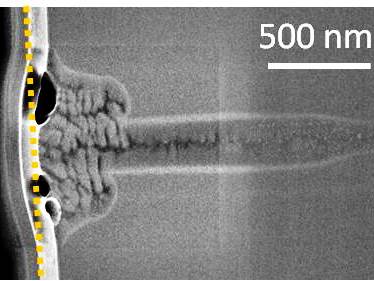On February 13, the Adlershof Dissertation Award was granted to Dr. Martin Hempel of the Max-Born-Institute (MBI). In competition with two other nominees and according to the jury's unanimous opinion, he presented best his dissertation work “Defect Mechanism in Diode Lasers at High Optical Output Power: The Catastrophic Optical Damage“.
As a student, Martin Hempel was fascinated by research on novel semiconductor diode lasers. As a PhD student at MBI, he investigated the ultimate performance limits of these universal devices. His research was focused on the so-called Catastrophic Optical Damage (COD), a defect mechanism that affects semiconductor diode lasers at very high optical intensities. A volume of ~1 µm³ of the laser crystal is heated up to ~1600°C by re-absorbed laser light. This temperature jump takes place in just 1 ns. Subsequently, the COD defect expands in the laser cavity with a velocity of about 90 km/h. The entire diode laser is degraded after a few µs. The final COD defect volume is approx. 1000 times larger than the initial COD starting point. Hempel was able to resolve the spatio-temporal dynamics of the COD process by a combination of methods. His results provide new insight into the physical mechanisms behind the COD. Based on this knowledge, it is possible to identify the root causes for device failures in an efficient and fast manner. In close cooperation with manufacturers of diode lasers this makes it possible to increase output power and reliability of the devices.
About the prize:
Each year since 2002, IGAFA, Humboldt University and WISTA-MANAGEMENT GmbH jointly award the Adlershof Dissertation Prize to young scientists for PhD research which was conducted at one of the research institutions in Adlershof and got an excellent grade of the scientific quality of their work. Three selected nominees present their dissertation work in form of short talks to a general audience. The jury then makes the decision which of the finalists not only conducts excellent research but also explains complex topics enthusiastically and in simple terms.
Fig. 1: Electron microscopy image of a device damaged by COD. The front facet is indicated by the dotted line on the left side. The material extrusion is clearly visible there. The degradation of the active laser layer starts at the front facet and is expanded up to the right edge of the image. A crystallographic interpretation of the changes of the material composition in the damaged volume indicates the presence of a temperature around 1600°C.
 Fig. 2: COD defect pattern in the active layer of a diode laser (grey
Fig. 2: COD defect pattern in the active layer of a diode laser (grey
shaded area). The thermal signature of the COD defect front was mapped
temporally resolved by a thermocamera. This was done by monitoring the
side of the laser cavity (along z axis) and the front facet (along x) in
parallel. The center of gravity of these signals, seen form two sides
of the device, gives the position of the defect front (black dots).
Thermography is demonstrated to be a tool to resolve the motion of the
COD defect front temporally and spatially at once. In the upper part,
thermal images are shown, record at different times while looking on the
front facet. The corresponding positions in the x-z-diagram are marked.
The constant signal amplitude indicates a constant temperature during
the entire COD defect growth. Evaluating the temporal and spatial data
gives a velocity of ~90 km/h for the movement of the defect front along
the laser cavity. (Fig. MBI)
Contact:
| Dr. Martin Hempel, phone: +49 (0) 30 – 6392 1453 E-Mail: hempelmbi-berlin.de |


